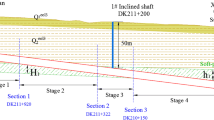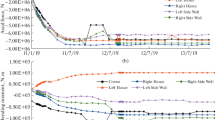Abstract
This paper presents a case study of a large cross-section high-speed railway tunnel constructed in a binary stratum of Q2 loess—soft-plastic loess sandwiched between hard loess. The distresses during tunnel construction include lining cracking, water seepage, falling blocks at the excavation face, cavities behind the lining, and collapse of surrounding loess. The day-lighting collapse of surrounding rocks induced subsidence of the ground surface. The relationship between the soft-plastic loess permeability coefficient and the void ratio is obtained by triaxial seepage unloading tests and embedded into a 3D fluid-mechanical coupled numerical analysis. The results show that when the tunnel passes beneath the soft-plastic loess layer, the instability of the surrounding loess first initiates at the excavation face and further develops with the water migration. The soft-plastic loess extrudes into the free face, and the benches are immersed in water. The shear failure of overlain surrounding loess finally occurs along the weak surface in the arch section. The collapse also causes damage to the tunnel’s supporting structure. The arch crown fails due to excessive tensile and shear stresses, and the sidewalls experience failure due to excessive compression. A scheme of grouting plus pipe roofing was proposed to treat the collapse zone, and field monitoring proved the effectiveness of the proposed method.























Similar content being viewed by others
Data availability statement
All data, models, and codes included in this paper are available from the corresponding author upon reasonable request.
References
Avram A, Constantin D, Hao Q, Timar-Gabor A (2022) Optically stimulated luminescence dating of loess in South-Eastern China using quartz and polymineral fine grains. Quat Geochronol 67:101226
Cui G, Ma J, Wang D (2021) A large 3D laboratory test on the deformation characteristic of shallow loess tunnel under different plastic states. Bull Eng Geol Env 80(10):7577–7590
Chegbeleh LP, Akabzaa TM, Akudago JA, Yidana SM (2019) Investigation of critical hydraulic gradient and its application to the design and construction of bentonite-grout curtain. Environ Earth Sci 78(12):370
Cheng X, Zhou X, Liu H, Zhou Y, Shi W (2021) Numerical analysis and shaking table test of seismic response of tunnel in a loess soil considering rainfall and traffic load. Rock Mech Rock Eng 54(2)
Fan S, Song Z, Zhang Y, Liu N (2020) Case study of the effect of rainfall infiltration on a tunnel underlying the roadbed slope with weak inter-layer. KSCE J Civ Eng 24(5):1607–1619
Farhadian H, Nikvar-Hassani A (2019) Water flow into tunnels in discontinuous rock: a short critical review of the analytical solution of the art. Bull Eng Geol Env 78(5):3833–3849
Golian M, Teshnizi ES, Parise M (2021) A new analytical method for determination of discharge duration in tunnels subjected to groundwater inrush. Bull Eng Geol Env 80(4):3293–3313
Hassanpour J, Lotfipoor A, Morsali M (2021) Introduction of an empirical classification system for evaluating tunneling impact on the discharge of springs (TIS) in the surrounding areas. Bull Eng Geol Env 80(7):5725–5742
Hong Q, Lai H, Liu Y (2023) Failure analysis and treatments of collapse accidents in loess tunnels. Eng Fail Anal 145:107037
Hong Q, Lai H, Liu Y, Chen R, Liu C, Xie J (2021a) A case study on deformation characteristics of a large cross-section tunnel passing through a soft-plastic layer with different spatial locations. Arab J Geosci 14:272
Hong Q, Lai H, Liu Y et al (2021b) Deformation control method of a large cross-section tunnel overlaid by a soft-plastic loess layer: a case study. Bull Eng Geol Env 80(6):4717–4730
Itasca Consulting Group Inc. (2012) FLAC3D (Fast Lagrangian Analysis of Continua in 3 Dimensions), version 5.0 Minneapolis
Jiang M, Sima J, Cui Y et al (2017) Experimental investigation of the deformation characteristics of natural loess under the stress paths in shield tunnel excavation. Int J Geomech 17(9):04017079
Kim Y, Moon J (2020) Change of groundwater inflow by cutoff grouting thickness and permeability coefficient. Geomech Eng 21(2):165–170
Lai H, Song W, Liu Y et al (2017) Influence of flooded loessial overburden on the tunnel lining: case study. J Perform Constr Facil 31(6)
Lai H, Zheng H, Chen R, Kang Z, Liu Y (2020) Settlement behaviors of existing tunnel caused by obliquely under-crossing shield tunneling in close proximity with small intersection angle. Tunn Undergr Space Technol 97:103258
Li P, Zhao Y, Zhou X (2016) Displacement characteristics of high-speed railway tunnel construction in loess ground by using multi-step excavation method. Tunn Undergr Space Technol Inc Trenchless Technol Res 51:41–55
Liang Q, Li J, Wu X et al (2016) Anisotropy of Q2 loess in the baijiapo tunnel on the Lanyu railway, China. Bull Eng Geol Env 75(1):109–124
Liu C, Li F (2011) Loess highway tunnel supports stress analysis and construction method mechanism. Adv Mater Res 243–249:3385–3388
Liu Y, Lai H, Xie Y et al (2017) Cracks analysis of highway tunnel lining in flooded loess. Geotech Eng 170(1):1–11
Luo Y, Chen J, Gao S, Deng X, Diao P (2017) Stability analysis of super-large-section tunnel in loess ground considering water infiltration caused by irrigation. Environ Earth Sci 76(22):763.1–763.17
Ma D, Miao X, Bai H, Huang J, Pu H, Wu Y, Zhang G, Li J (2016) Effect of mining on shear sidewall groundwater inrush hazard caused by seepage instability of the penetrated karst collapse pillar. Nat Hazards 82(1):73–93
Mao Z, Wang X, An N, Li X, Wei R (2019) Water disaster susceptible areas in loess multi-arch tunnel construction under the lateral recharge condition. KSCE J Civ Eng 23(10):4565–4577
Mao Z, Wang X, An N, Li X, Wei R, Wang Y, Wu H (2020) Water leakage susceptible areas in loess multi-arch tunnel operation under the lateral recharge conditions. Environ Earth Sci 79(15):1–32
Marinos V, Goricki A, Malandrakis E (2019) Determining the principles of tunnel support based on the engineering geological behaviour types: example of a tunnel in tectonically disturbed heterogeneous rock in Serbia. Bull Eng Geol Env 78(4):2887–2902
Mashhadban H, Choobbasti AJ, Shooshpasha I (2020) Evaluation of the seismic response of the slopes in the presence of the horseshoe tunnel0. Bull Eng Geol Env 80(1):157–177
Nikbakhti O, Hashemi M, Banikheir M, Basmenj A (2018) Geoenvironmental assessment of the formation and expansion of earth fissures as geological hazards along the route of the Haram-to-Haram Highway, Iran. Bull Eng Geol Environ 77(4):1421–1438
Oreste P, Sebastiani D, Spagnoli G, Lillis AD (2021) Analysis of the behavior of the two-component grout around a tunnel segmental lining on the basis of experimental results and analytical approaches. Transp Geotech 29:100570
Paraskevopoulou C, Diederichs M (2018) Analysis of time-dependent deformation in tunnels using the convergence-confinement method. Tunn Undergr Space Technol 71:62–80
Sun W, Liang QG, Qin SH, Yuan YX, Zhang TJ (2021) Evaluation of groundwater effects on tunnel engineering in loess. Bull Eng Geol Env 80(3):1947–1962
Tang X, Gan P, Liu W, Zhao Y (2017) Surface settlements induced by tunneling in permeable strata: a case history of Shenzhen Metro. J Zhejiang Univ-SCI A 18(10):757–775
Wang DK, Luo JJ, Shen KM, Gao LP, Li FL, Wang L (2022a) Analysis of the causes of the collapse of a deep-buried large cross-section of loess tunnel and evaluation of treatment measures. Appl Sci 12(1):161
Wang J, Li P, Ma Y et al (2018) Influence of irrigation method on the infiltration in loess: field study in the Loess Plateau. Desalin Water Treat 110:298–307
Wang Z, Shi Y, Xie Y, Zhang M, Liu T, Li C, Zhang C (2022b) Support characteristic of a novel type of support in loess tunnels using the convergence–confinement method. Int J Geomech 21(10):06021026
Wei ZD, Zhu YP (2021) Seepage in water-rich loess tunnel excavating process and grouting control effect. Geofluids 2021:5597845
Wongsaroj J, Soga K, Mair R (2013) Tunnelling-induced consolidation settlements in London Clay. Geotechnique 63(13):1103–1115
Xu Z, Cai N, Li X, Xian M, Dong T (2021) Risk assessment of loess tunnel collapse during construction based on an attribute recognition model. Bull Eng Geol Env 80(8):6205–6220
Xue Y, Zhang X, Li S et al (2018) Analysis of factors influencing tunnel deformation in loess deposits by data mining: a deformation prediction model. Eng Geol 232:94–103
Yan Q, Li S, Xie C, Li Y (2018) Analytical solution for bolted tunnels in expansive loess using the convergence-confinement method. Int J Geomech 18(1):04017124
Zhang D, Xie X, Zhou M, Huang Z, Zhang D (2021) An incident of water and soil gushing in a metro tunnel due to high water pressure in sandy silt. Eng Fail Anal 121:105196
Zhang Y, Hu Z, Hao C et al (2018) Experimental investigation of the behavior of collapsible loess treated with the acid-addition pre-soaking method. KSCE J Civ Eng 22(11):4373–4384
Zhao M, Wei K, Wen Z et al (2013) Study on the response of surrounding rock for gob-side entry retaining under the mining. Appl Mech Mater 448–453:3879–3883
Zhao Y, He H, Li P (2018) Key techniques for the construction of high-speed railway large-section loess tunnels. Engineering 4(2):193–205
Zhu HY, Chen JX, Luo YB, Li Y, Wu YF (2020) The angle for setting foot reinforcement bolt based on the failure mode of shallow tunnel in loess. Tunn Undergr Space Technol 108(4):103689
Funding
The authors acknowledge the financial support provided by the National Natural Science Foundation of China (Grant Nos. 51978064, 52278391, and 51908051) and the Scientific Research Project of Introducing Talents, Anhui Jianzhu University (Grant No. 2022QDZ24).
Author information
Authors and Affiliations
Corresponding author
Ethics declarations
Conflict of interest
The authors declare no competing interests.
Additional information
I would like to declare on behalf of my coauthors that the work described was original research that has not been published previously and is not under consideration for publication elsewhere, in whole or in part.
Rights and permissions
Springer Nature or its licensor (e.g. a society or other partner) holds exclusive rights to this article under a publishing agreement with the author(s) or other rightsholder(s); author self-archiving of the accepted manuscript version of this article is solely governed by the terms of such publishing agreement and applicable law.
About this article
Cite this article
Hong, Q., Lai, H., Liu, Y. et al. Distress mechanism and treatment measures in construction of large cross-section tunnel passing through Q2 soft-plastic loess layer. Bull Eng Geol Environ 82, 165 (2023). https://doi.org/10.1007/s10064-023-03197-1
Received:
Accepted:
Published:
DOI: https://doi.org/10.1007/s10064-023-03197-1




